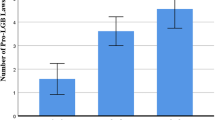Abstract
Studies have shown that attitudes toward abortion are polarizing. Yet, these studies have not focused upon what is often assumed to be the cause of polarization—religion. In this paper I find that polarization has increased between mainline and evangelical Protestants, as well as between black Protestants and both Catholics and white evangelicals. Moreover, I find that mainline Protestants and Catholics are internally polarizing. Finally, while I cannot determine the cause of the internal polarization of Catholics, the polarization within mainline Protestantism is caused by demographic changes. For white evangelicals, demographic changes have restrained polarization that would otherwise have occurred.
Similar content being viewed by others
REFERENCES
Brint, Steven 1994 In an Age of Experts: The Changing Role of Professionals in Politics and Public Life. Princeton: Princeton University Press.
Burns, Gene 1992 The Frontiers of Catholicism: The Politics of Ideology in a Liberal World. Berkeley: University of California Press.
Clogg, Clifford C., and Darwin O. Sawyer 1981 “A comparison of alternative models for analyzing the scalability of response patterns.” Sociological Methodology 12:240-280.
Davis, Nancy J., and Robert V. Robinson 1996 “Are rumors of war exaggerated? Religious orthodoxy and moral progressivism in America.” American Journal of Sociology 102(3):756-776.
DiMaggio, Paul, John Evans, and Bethany Bryson 1996 “Have Americans' social attitudes become more polarized?” American Journal of Sociology 102:690-755.
Duncan, Otis Dudley, Douglas M. Sloane, and Charles Brody 1982 “Latent classes inferred from response-consistency effects.” In K. G. Joreskog and H. Wold (eds.), Systems Under Indirect Observation: Causality, Structure, Prediction: 18-64. Amsterdam: North-Holland.
Epstein, Lee, and Joseph F. Kobylka 1992 The Supreme Court and Legal Change. Chapel Hill, NC: University of North Carolina Press.
Evans, John H. 1997a “Multi-organizational fields and social movement organization frame content: The religious pro-choice movement.” Sociological Inquiry 67(4):451-469.
11997b “Worldviews or social groups as the source of moral value attitudes: Implications for the culture wars thesis.” Sociological Forum 12(3):371-404.
Evans, John H., Bethany Bryson, and Paul DiMaggio 2001 “Opinion polarization: Important contributions, necessary limitations.” American Journal of Sociology 106(4):944-959.
Finke, Roger, and Patricia Wittberg 2000 “Organizational revival from within: Explaining revivalism and reform in the Roman Catholic Church.” Journal for the Scientific Study of Religion 39(2):154-170.
Gay, David A., Christopher G. Ellison, and Daniel A. Powers 1996 “In search of denominational subcultures: Religious affiliation and ‘pro-family’ issues revisited.” Review of Religious Research 38:3-17.
Gay, David, and John Lynxwiler 1999 “The impact of religiosity on race variations in abortion attitudes.” Sociological Spectrum 19:359-377.
Gillespie, Michael W., Elisabeth M. Ten Vergert, and Johannes Kingma 1987 “Using Mokken scale analysis to develop unidimensional scales: Dothe six abortion items in the NORCGSS form one or two scales?” Quality and Quantity 21:393-408.
11988 “Secular trends in abortion attitudes: 1975–1980–1985.” The Journal of Psychology 122(4):323-341.
Hoffmann, John P., and Alan S. Miller 1997 “Social and political attitudes among religious groups: Convergence and divergence over time.” Journal for the Scientific Study of Religion 36(1):52-70.
11998 “Denominational influences on socially divisive issues.” Journal for the Scientific Study of Religion 37(3):528-546.
Hunter, James D. 1991 Culture Wars: The Struggle to Define America. New York: Basic Books.
11994 Before the Shooting Begins: Searching for Democracy in America's Culture War. New York: Free Press.
Iannaccone, Laurence R. 1994 “Why strict churches are strong.” American Journal of Sociology 99(5):1180-1211.
Kelley, Dean M. 1972 Why Conservative Churches are Growing. New York: Harper and Row.
Lenski, Gerhard 1958 The Religious Factor. Garden City, NY: Anchor Books.
Manza, Jeff, and Clem Brooks 1997 “The religious factor in U.S. presidential elections, 1960–1992.” American Journal of Sociology 103(1):38-81.
Mouw, Ted, and Michael E. Sobel 2001 “Culture wars and opinion polarization: The case of abortion.” American Journal of Sociology 106(4):913-943.
Muthen, Bengt 1982 “Some categorical response models with continuous latent variables.” In K. G. Joreskog and H. Wold (eds.), Systems Under Indirect Observation: Causality, Structure, Prediction: 65-80. Amsterdam: North-Holland.
Ostrom, Charles W. 1990 Time Series Analysis: Regression Techniques. Newbury Park, CA: Sage.
Page, Benjamin I., and Robert Y. Shapiro 1992 The Rational Public: Fifty Years of Trends in Americans' Policy Preferences. Chicago: University of Chicago Press.
Schmalzbauer, John 1993 “Evangelicals in the new class: Class versus subcultural predictors of ideology.” Journal for the Scientific Study of Religion 32(4):330-342.
Shapiro, Robert Y., and Harpreet Mahajan 1986 “Gender differences in policy preferences: A summary of trends from the 1960s to the 1980s.” Public Opinion Quarterly 50:42-61.
Snow, David A., Rochford, E. Burke, Worden, Steven K., and Benford, Robert D. 1986 “Frame alignment processes, micro-mobilization, and movement participation.” American Sociological Review 51:464-481.
Steensland, Brian, Park, Jerry Z., Regnerus, Mark D., Robinson, Lynn D., Wilcox W. Bradford, and Woodberry, Robert D. 2000 “The measure of American religion: Toward improving the state of the art.” Social Forces 79(1):291-318.
U.S. House of Representatives 1976 Proposed Constitutional Amendments on Abortion. Hearings before the Subcommittee on Civil and Constitutional Rights of the Committee on the Judiciary, House of Representatives. Washington, DC: U.S. Government Printing Office.
Warner, R. Stephen 1993 “Work in progress toward a new paradigm for the sociological study of religion in the United States.” American Journal of Sociology 98(5):1044-1093.
Williams, Rhys H. 1997 Cultural Wars in American Politics: Critical Reviews of a Popular Thesis. Hawthorn, NY: Aldine de Gruyter.
Winship, Christopher, and Robert D. Mare 1984 “Regression models with ordinal variables.” American Sociological Review 49:512-525.
Wuthnow, Robert 1988 The Restructuring of American Religion. Princeton, NJ: Princeton University Press.
Author information
Authors and Affiliations
Rights and permissions
About this article
Cite this article
Evans, J.H. Polarization in Abortion Attitudes in U.S. Religious Traditions, 1972–1998. Sociological Forum 17, 397–422 (2002). https://doi.org/10.1023/A:1019627006778
Issue Date:
DOI: https://doi.org/10.1023/A:1019627006778




